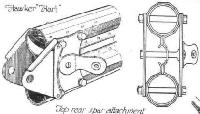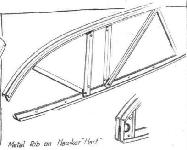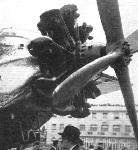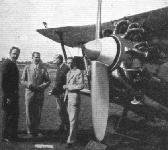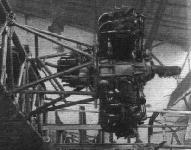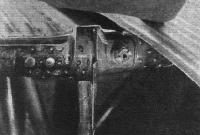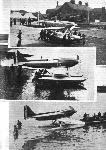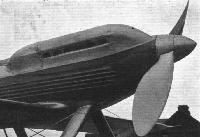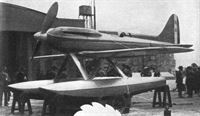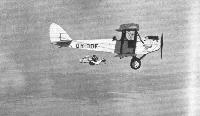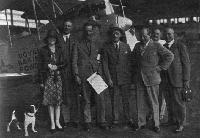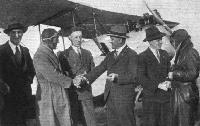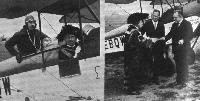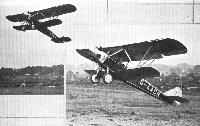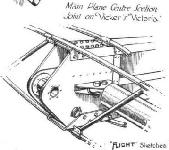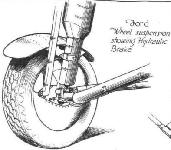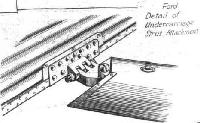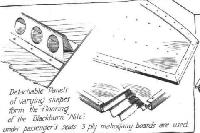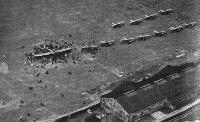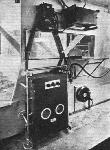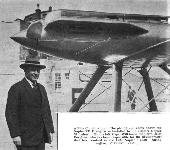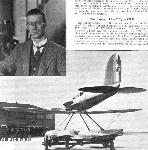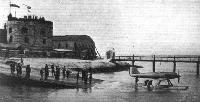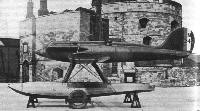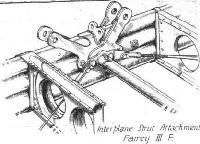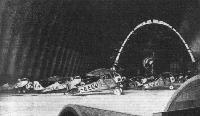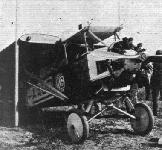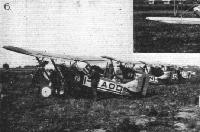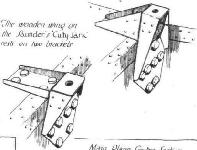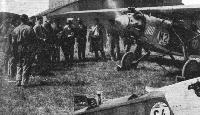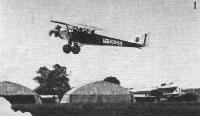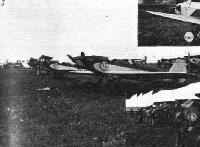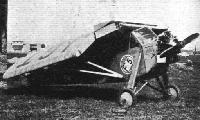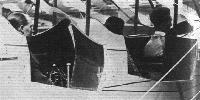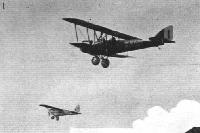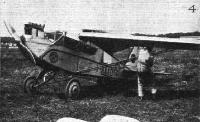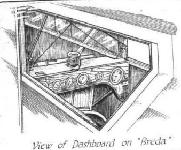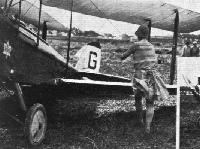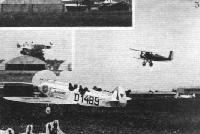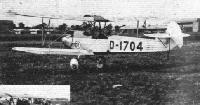Фотографии
-
Hawker "Hart" Tor rear spar attachment
Самолёты на фотографии: Hawker Hart - Великобритания - 1928
-
Metal Rib on Hawker "Hart"
Самолёты на фотографии: Hawker Hart - Великобритания - 1928
-
An aerial view of the Fokker monoplane gliding into London's air port at Croydon.
Самолёты на фотографии: Fokker F.VII / C-2 / F.XIV - Нидерланды - 1924
-
Регистрационный номер: G-EBTS [2], H-NADK [2] Not exactly a Grecian nose, but it functioned splendidly. The Bristol "Jupiter" engine in the Duchess of Bedford's Fokker monoplane, which was not disturbed by 10,000 miles in eight days.
Самолёты на фотографии: Fokker F.VII / C-2 / F.XIV - Нидерланды - 1924
-
Регистрационный номер: G-EBTS [2], H-NADK [2] Return of "The Spider." A successful finish to the flight to India and back. Landing at Croydon August 9.
Самолёты на фотографии: Fokker F.VII / C-2 / F.XIV - Нидерланды - 1924
-
Spanish Visitors to Filton: The week before last Their Royal Highnesses the Archdukes Francisco and Antonio, cousins of the King of Spain, who are on a tour of Europe, arrived at Filton by "Moth," and inspected the Bristol works and machines. During the evening they were entertained at his home by Mr. H. J. Thomas, a director and works manager of the Bristol Co. The next day the visitors were given a civic luncheon by the Lord Mayor of Birmingham.
Самолёты на фотографии: Bristol Bulldog - Великобритания - 1927
-
The ANT-9 exhibited on the Krasnaja Ploschad in Moscow.
Самолёты на фотографии: Туполев АНТ-9 / ПС-9 - Россия - 1929
-
THE ANT-9: Three-quarter Front View.
Самолёты на фотографии: Туполев АНТ-9 / ПС-9 - Россия - 1929
-
View from above, showing landing gear, front portion of fuselage, and wing engines. Note the neat engine cowling.
Самолёты на фотографии: Туполев АНТ-9 / ПС-9 - Россия - 1929
-
The wing spar construction: Booms as well as braces are of Koltchugalumin tubes.
Самолёты на фотографии: Туполев АНТ-9 / ПС-9 - Россия - 1929
-
FUSELAGE CONSTRUCTION OF THE ANT-9: On the left, the saloon portion, showing main frames. On the right, the structure of the aft portion of the body, in Koltchugalumin tube construction.
Самолёты на фотографии: Туполев АНТ-9 / ПС-9 - Россия - 1929
-
A Wing Engine and its tubular mounting on wing centre-section.
Самолёты на фотографии: Туполев АНТ-9 / ПС-9 - Россия - 1929
-
Detail of tubular wing spar boom joint, for connecting centre-section to outer wing portions.
Самолёты на фотографии: Туполев АНТ-9 / ПС-9 - Россия - 1929
-
Structure of wing centre-section, with outer wing portion attached. Below, the inner end of wing tip, with fuel tank. Note socketed joints for attachment of multi-spars.
Самолёты на фотографии: Туполев АНТ-9 / ПС-9 - Россия - 1929
-
FIRST RUSSIAN ALL-METAL PASSENGER AEROPLANE: Side View of the C.A.H.I. ANT-9.
Самолёты на фотографии: Туполев АНТ-9 / ПС-9 - Россия - 1929
-
The Saloon of the ANT-9: View looking forward. The pilots' cockpit can be seen through the open door in the front wall.
Самолёты на фотографии: Туполев АНТ-9 / ПС-9 - Россия - 1929
-
Регистрационный номер: N247 [4] PREPARING FOR FLIGHT: Starting the Rolls-Royce engine of the new Supermarine S.6 by means of a Bristol gas starter.
Самолёты на фотографии: Supermarine S.5 / S.6 - Великобритания - 1927
-
Регистрационный номер: N247 [4] LAUNCHING THE SUPERMARINE ROLLS-ROYCE S.6: Above, Wheeling the machine down the slipway. In the centre, Taking the water. And below, The machine afloat, ready to be towed out.
Самолёты на фотографии: Supermarine S.5 / S.6 - Великобритания - 1927
-
S.6 in Flight
Самолёты на фотографии: Supermarine S.5 / S.6 - Великобритания - 1927
-
The Business End of the Supermarine S.6: Of the Rolls-Royce "R" type engine nothing is seen but the exhaust ports.
Самолёты на фотографии: Supermarine S.5 / S.6 - Великобритания - 1927
-
Регистрационный номер: N247 [4] A WEIRD CRAFT: The Supermarine-Rolls-Royce S.6 on board one of the special pontoons used for transport purposes.
Самолёты на фотографии: Supermarine S.5 / S.6 - Великобритания - 1927
-
Регистрационный номер: N247 [4] ONE OF THE BRITISH 1929 DEFENDERS: The Supermarine S.6 is an all-metal low-wing monoplane, fitted with Rolls-Royce "R" type engine.
Самолёты на фотографии: Supermarine S.5 / S.6 - Великобритания - 1927
-
A VISITOR FROM THE NEAR EAST: His Excellency Sheikh Hafidh Wahba - a Delegate from Hejas to the recent Postal Congress - visited the Works of Petters, Ltd., Yeovil. The Westland IV, in which he took a flight, is shown in the background. Left to right, Mr. E. M. Benjamin, Capt. Paget, Mr. P. W. Petter (Managing Director of Petters, Ltd.), His Excellency Sheikh Hafidh Wahba, Mr. All Shukry Bey, Mr. T. D. Cree, Capt. R. C. Petter, Capt. Hill, Mr. R. J. Norton.
Самолёты на фотографии: Westland Wessex / Westland IV - Великобритания - 1929
-
Регистрационный номер: OY-DOF PARTING COMPANY! This remarkable photograph shows Mr. John Tranum and his Russell-Lobe parachute just after quitting the "Moth" belonging to Mr. M. E. I. Jensen above Kastrup Aerodrome, Copenhagen, at an altitude lof 3,000 feet. The photograph was taken from another "Moth" belonging to Mr. Thielst.
Самолёты на фотографии: De Havilland Moth / D.H.60 - Великобритания - 1925
-
Flt.-Lieut. R. R. Bentley, A.F.C., has just completed his fourth flight between South Africa and Great Britain in the same Cirrus-Moth. His latest trip was for the purpose of flying a business man, Mr. M. Filsinger, to Germany from Johannesburg. They left on July 10, and reached Berlin on August 22, having flown via Nairobi, Cairo, Constantinople, Sofia, Vienna and Prague. Flt.-Lieut. Bentley then flew on to London. Our illustration marks the arrival at Berlin. (Left to right) Mrs. Bentley, Mr. M. Filsinger, Flight-Lieut. Bentley, Dr. Millner, and Capt. Udet, the German wartime "ace."
Самолёты на фотографии: De Havilland Moth / D.H.60 - Великобритания - 1925
-
A Landing Ground Campaign has been carried out in South Australia, sponsored by Louis Coen Wireless Pty. Ltd., who are said to be the first company in the Dominion to use aircraft for conveying their commercial travellers on a regular circuit, and own three D.H. "Moths." The Vacuum Oil Co. Pty., Ltd., also contributed to the campaign, which resulted in over 130 towns being inspected and the selection of many sites. Our illustration marks the conclusion of a section of the campaign in South Australia, when over 50 towns in the State were visited. Officials of the South Australia Aero Club congratulate the Victorian airmen on their useful work. (Left to right): Capt. Roberts, pilot of a touring machine : Mr. A. C. Hewitt (Club President), Mr. J. Churchill Smith (Club Secretary), Mr. B. Skeil (Organiser), and Capt. Mollison, late R.A.F. (Club Instructor).
Самолёты на фотографии: De Havilland Moth / D.H.60 - Великобритания - 1925
-
Регистрационный номер: G-EBQW The Lord Mayor of Nottingham (Alderman A. R. Atkey) receiving the licence for the new Nottingham Corporation Aerodrome (Tollerton) from Mr. F. Montague, Under Secretary of State for Air, at Stag Lane Aerodrome on July 27, after flying down from Nottingham. He immediately flew back to perform the opening ceremony at which Sir Alan Cobham was present. Our illustrations show the Under Secretary for Air presenting the Mayor with the licence, with Air Vice-Marshal Sir Sefton Brancker an interested witness, and the arrival in the Nottingham Club's D.H. "Moth," piloted by Flight-Lieut. F. L. Bateman.
Самолёты на фотографии: De Havilland Moth / D.H.60 - Великобритания - 1925
-
Engine Mounting on Parnall "Elf" and detail of it's attachment to Fuselage
Самолёты на фотографии: Parnall Elf - Великобритания - 1929
-
Aileron Hinge and Wing Root on the Boulton & Paul "Sidestrand"
Самолёты на фотографии: Boulton Paul Sidestrand / P.29 - Великобритания - 1926
-
Регистрационный номер: G-AACN A "GUGNUNC" JAMBOREE: The Machine designed and built by Handley Page, Ltd., for the Guggenheim Competition is liberally slotted. That it has both lateral stability at large angles and a steep angle of climb is shown by these two photographs, which show the machine just after leaving the ground and well away. The engine fitted is an Armstrong-Siddeley "Mongoose."
The sad story of the Handley Page HP 39 Gugnunc is a case of a bruised ego pouring good money after bad in what always looked to be a futile exercise. First flown on 30 April 1929, the sole HP 39, G-AACN, was built specifically to compete in the US-based Guggenheim Safe Aircraft Competition, which Frederick Handley Page felt would be a great showcase for his likely winner of a design. This was not to be the case, for after some protracted wrangling the declared winner was the Curtiss Tanager, the HP 39 being unplaced. This somewhat dubious result even engendered critical comment from parts of the American aviation press. Meanwhile, a disgruntled Handley Page involved the company in spending additional sums to those already incurred on the US trip, by taking out a lawsuit against Curtiss for non-payment of royalties for what Handley Page considered were his patented wing slots. This judgement would also go against him. Seen here being flown by J. Cordes from the company's Cricklewood airfield in June 1929, the HP 39 was powered by a 150hp Armstrong Siddeley Mongoose and had an impressive speed range of 112.5 to 33.5mph.Самолёты на фотографии: Handley Page Gugnunc / H.P.39 - Великобритания - 1929
-
Duralumin Elevator on Westland "Wapiti"
Самолёты на фотографии: Westland Wapiti - Великобритания - 1927
-
Регистрационный номер: D-1707 Preliminaries : Weighing in the Arado-Warnemundel L.I. (70 Salmson) at Orly.
Самолёты на фотографии: Arado L.I - Германия - 1929
-
Регистрационный номер: L-BABH [2] THE FOLDING TEST AT ORLY: (1) Avia Antelope (Walter engine) with German B.F.W. in the rear
Самолёты на фотографии: Avia BH-9 / BH-10 / BH-11 / BH-12 / BH-16 - Чехословакия - 1923Messerschmitt BFW M.23 / M.27 - Германия - 1928
-
Регистрационный номер: L-BABH [2] PETROL TEST AT THE ORLY MEETING: (2) The French Caudron 193 low-wing monoplane and the Avia Antelope (Walter)
Самолёты на фотографии: Avia BH-9 / BH-10 / BH-11 / BH-12 / BH-16 - Чехословакия - 1923Caudron C.190 - Франция - 1929
-
Front Spar Locking Pin on metal "Avian"
Самолёты на фотографии: Avro Avian / Type 594/616 - Великобритания - 1926
-
Main Plane Centre Section Joint on Vickers's "Victoria"
Самолёты на фотографии: Vickers Victoria - Великобритания - 1922
-
AUSTRALIAN AIR MAIL DEVELOPMENT: Arrival of the first Air Mail at Brisbane from Charleville, on April 22, flown by the D.H.61 (Bristol "Jupiter") "Apollo," operated by the Queensland and Northern Territories Aerial Services, Ltd. The distance of 444 miles is covered in 5 1/2 hours.
Самолёты на фотографии: De Havilland Giant Moth / D.H.61 - Великобритания - 1927
-
Ford Wheel suspension showing Hydraulic Brake
Самолёты на фотографии: Ford Tri-Motor / 4-AT / 5-AT - США - 1926
-
Ford Detail of Undercarriage Strut Attachment
Самолёты на фотографии: Ford Tri-Motor / 4-AT / 5-AT - США - 1926
-
Detachable Panels of varying shapes form the flooring of the Blackburn "Nile": under passenger's seats 3 ply mahogany boards are used
Самолёты на фотографии: Blackburn Sydney / R.B.2 - Великобритания - 1930
-
TWENTY YEARS AFTER: On July 27 M. Bieriot again flew the Channel, this time in the latest type of Bieriot monoplane, to celebrate his historic flight on July 25, 1909. Our picture shows the crowd around the machine after he landed at Swingate, Dover; he is standing on the machine with the Mayor of Dover. Inset, the machine arriving.
Самолёты на фотографии: Bleriot Bleriot-127 / -137 - Франция - 1926
-
THE SECOND CHANNEL CROSSING: An aerial view showing the Bieriot monoplane, in which M. Bleriot crossed the Channel on Saturday, immediately after landing at Swingate, Dover. The R.A.F. escorting machines are seen alongside.
Самолёты на фотографии: Bleriot Bleriot-127 / -137 - Франция - 1926
-
THE CAPRONI "CA. 97 COMMERCIAL": This is a three-engined version of the "Colonial" for commercial air services.
Самолёты на фотографии: Caproni Ca.97 - Италия - 1927
-
THE CAPRONI "CA. 97 COLONIAL": Two views of this Italian all-metal machine, which is intended for Colonial military service.
Самолёты на фотографии: Caproni Ca.97 - Италия - 1927
-
A view inside the Caproni "Ca. 97 Colonial," showing the wireless installation.
Самолёты на фотографии: Caproni Ca.97 - Италия - 1927
-
Регистрационный номер: N249 [5] Daintiness personified: This side view of the Gloster-Napier VI gives, by the "scale" supplied by the R.A.F. personnel standing around, a good idea of the smallness of the machine.
Самолёты на фотографии: Gloster VI Golden Arrow - Великобритания - 1929
-
Регистрационный номер: N249 [5] A Fine Combination: The photograph shows the Napier VII D engine as installed in the Gloster-Napier VI. On the left, Capt. Wilkinson, Napier's Chief Designer, who has been responsible for the development that has resulted in the 1929 Napier "Lion" racing engine.
Самолёты на фотографии: Gloster VI Golden Arrow - Великобритания - 1929
-
THE GLOSTER-NAPIER VI: The extremely small cross-sectional area is well brought out in these front and rear views.
Самолёты на фотографии: Gloster VI Golden Arrow - Великобритания - 1929
-
Регистрационный номер: N249 [5] THE MAN AND THE MACHINE: Above, Mr. H. P. Folland, Chief Engineer and Designer of the Gloster Aircraft Co., and the very pretty monoplane produced for this year's Schneider Trophy Contest.
Самолёты на фотографии: Gloster VI Golden Arrow - Великобритания - 1929
-
Регистрационный номер: N249 [5] King of the Castle? The Gloster 6 racing monoplane (Napier racing engine), standing easy within the shadow of Calshot Castle. Its secret performance creates a fascinating speculation.
Самолёты на фотографии: Gloster VI Golden Arrow - Великобритания - 1929
-
The Napier "Lion" VII D: Of even smaller overall size than the 1927 model, this year's Napier racing engine is supercharged, and gives considerably more power than previous types.
Самолёты на фотографии: Gloster VI Golden Arrow - Великобритания - 1929
-
Регистрационный номер: N249 [5] Самолёты на фотографии: Gloster VI Golden Arrow - Великобритания - 1929
-
Регистрационный номер: G-AAII [2] Самолёты на фотографии: Southern Martlet - Великобритания - 1929
-
Регистрационный номер: G-AAII [2] Самолёты на фотографии: Southern Martlet - Великобритания - 1929
-
Interplane Strut Attachment Fairey III F.
Самолёты на фотографии: Fairey Fairey IIIF - Великобритания - 1926
-
Регистрационный номер: I-AAOC, I-AAOD [3] AT ORLY: Our picture shows a scene inside the large airship hangar at Orly on the occasion of the International Light 'Plane Tour of Europe.
Самолёты на фотографии: FIAT AS.1 / AS.2 / TR.1 - Италия - 1928
-
Регистрационный номер: I-AAOD [3] THE FOLDING TEST AT ORLY: (6) A very tight fit for the Fiat A.S.I. (Fiat engine).
Самолёты на фотографии: FIAT AS.1 / AS.2 / TR.1 - Италия - 1928
-
Регистрационный номер: I-AAOD [3] PETROL TEST AT THE ORLY MEETING: (6) Four Fiats A.S.I. (Fiat)
Самолёты на фотографии: FIAT AS.1 / AS.2 / TR.1 - Италия - 1928
-
The wooden wing on the Saunders's "Cutty Sark" rests on two brackets
Самолёты на фотографии: Saunders-Roe Cutty Sark / A.17 - Великобритания - 1929
-
Регистрационный номер: N223 TWO OF THE TRAINING MACHINES: Two Gloster IV's with Napier "Lion" engines are being used for practice purposes by this year's Schneider team.
Самолёты на фотографии: Gloster IV - Великобритания - 1926
-
ENGINE STARTING: One of the Ro. 5 (85 h.p. Fiat) light 'planes in the engine starting test.
Самолёты на фотографии: IMAM(Meridionali) Ro.5 - Италия - 1929
-
Регистрационный номер: I-FACE PETROL TEST AT THE ORLY MEETING: (1) Two of the Italian Romeo R 5's taking off
Самолёты на фотографии: IMAM(Meridionali) Ro.5 - Италия - 1929
-
PETROL TEST AT THE ORLY MEETING: (3) Two of the Junkers A.50's fitted with Genet engines, and Capt. Broad's Gipsy-Moth.
Самолёты на фотографии: De Havilland Gipsy Moth / Moth X - Великобритания - 1928Junkers A 50 Junior - Германия - 1929
-
Регистрационный номер: D-1683 PETROL TEST AT THE ORLY MEETING: (4) Filling up.
Самолёты на фотографии: Junkers A 50 Junior - Германия - 1929
-
PETROL TEST AT THE ORLY MEETING: (5) German and English competitors ready to start - the Junkers A.50 (Genets) and two Gipsy-Moths.
Самолёты на фотографии: De Havilland Gipsy Moth / Moth X - Великобритания - 1928Junkers A 50 Junior - Германия - 1929
-
Регистрационный номер: L-BASO [2] PETROL TEST AT THE ORLY MEETING: (2) The Genet-engined B.F.W. and the Aero 34 (Walter)
Самолёты на фотографии: Aero A.34 Kos - Чехословакия - 1929Messerschmitt BFW M.23 / M.27 - Германия - 1928
-
PETROL TEST AT THE ORLY MEETING: (4) Two B.F.W. monoplanes
Самолёты на фотографии: Messerschmitt BFW M.23 / M.27 - Германия - 1928
-
Регистрационный номер: D-1668, D-1675 THE FOLDING TEST AT ORLY: (5) Two of the German B.F.W. monoplanes, some of which were fitted with Genet engines and others with Siemens and Halske engines.
Самолёты на фотографии: Messerschmitt BFW M.23 / M.27 - Германия - 1928
-
PETROL TEST AT THE ORLY MEETING: (6) The French Potez await the word "Go."
Самолёты на фотографии: Potez Potez 36 - Франция - 1929
-
THE FOLDING TEST AT ORLY: (7) One of the French Potez 36 passing the test.
Самолёты на фотографии: Potez Potez 36 - Франция - 1929
-
Регистрационный номер: G-AAJY THE SHORT THREE-ENGINED TWIN-FLOAT MONOPLANE: Photographs of a scale model.
Самолёты на фотографии: Short Valetta / S.11 - Великобритания - 1930
-
AS A LANDPLANE: Although designed primarily as a twin-float seaplane, the new Short monoplane can be converted into a landplane by fitting a wheel undercarriage.
Самолёты на фотографии: Short Valetta / S.11 - Великобритания - 1930
-
Short Twin Float Commercial Monoplane 3 Bristol "Jupiter" Engines
Самолёты на фотографии: Short Valetta / S.11 - Великобритания - 1930
-
Lynx-Avros flown by the Oxford University Squadron group diving in formation over Manston
Самолёты на фотографии: Avro Avro 504N - Великобритания - 1920
-
Самолёты на фотографии: Avro Avro 504N - Великобритания - 1920
-
Регистрационный номер: J9252 [2] THE WESTLAND WIZARD II: Two more views of this machine, piloted by Capt. Louis Paget. Note the exceptionally clean lines.
Самолёты на фотографии: Westland Wizard - Великобритания - 1926
-
Регистрационный номер: J9252 [2] THE WESTLAND WIZARD II: A high-wing monoplane, fitted with a Rolls-Royce "F" Type engine.
Самолёты на фотографии: Westland Wizard - Великобритания - 1926
-
Spartan Ingenuity: The front cockpit of the three-seater Simmonds "Spartan" has a very clever seating arrangement whereby the front passenger may sit either facing forward or facing aft. The back-rest is hinged in such a way as to be capable of being swung upwards out of the way, as is also the middle windscreen. When the machine is used as a two-seater, a special cover is provided which covers the front part of the cockpit. If desired a slightly longer cover can be fitted, which completely covers the cockpit opening and may be used if the machine is flown solo.
Самолёты на фотографии: Simmonds Spartan - Великобритания - 1928
-
PETROL TEST AT THE ORLY MEETING: (1) Cant.26, an Italian machine with Isotta Fraschini 80 h.p. engine, and a Breda monoplane (Cirrus)
Самолёты на фотографии: Breda Ba.15 - Италия - 1928CANT CANT 26 - Италия - 1928
-
MEASURING PETROL AT ORLY: One of the Breda 15 monoplanes after the test.
Самолёты на фотографии: Breda Ba.15 - Италия - 1928
-
AT ORLY: Two of the Breda 15 monoplanes starting on their second lap in the consumption test.
Самолёты на фотографии: Breda Ba.15 - Италия - 1928
-
Регистрационный номер: I-AAAO THE FOLDING TEST AT ORLY: (4) One of the Breda 15 monoplanes with Cirrus engine.
Самолёты на фотографии: Breda Ba.15 - Италия - 1928
-
View of Dashboard on "Breda"
Самолёты на фотографии: Breda Ba.15 - Италия - 1928
-
THE FOLDING TEST AT ORLY: (3) Miss Winifred Spooner's Gypsy Moth essaying the test with ease
Самолёты на фотографии: De Havilland Gipsy Moth / Moth X - Великобритания - 1928
-
Wing Root on the De Havilland "Moth"
Самолёты на фотографии: De Havilland Gipsy Moth / Moth X - Великобритания - 1928
-
Регистрационный номер: F-AJHG The latest Caudron type 193 low-wing monoplane (85 h.p. Renault).
Самолёты на фотографии: Caudron C.190 - Франция - 1929
-
"John Carberry's" Raab Katzenstein, with Cirrus "Hermes" engine.
Самолёты на фотографии: Raab-Katzenstein RK.25 Ruhrland - Германия - 1928
-
Регистрационный номер: D-1489, D-1561 [2] PETROL TEST AT THE ORLY MEETING: (3) Raab-Katzenstein 25 with Cirrus engine and a fellow countryman in the Akadem Type D 18 with Genet engine
Самолёты на фотографии: Darmstadt D-18 - Германия - 1929Raab-Katzenstein RK.25 Ruhrland - Германия - 1928
-
Регистрационный номер: D-1561 [2] The Akadem. Fliegergruppe type D.18 (Armstrong-Siddeley "Genet.")
Самолёты на фотографии: Darmstadt D-18 - Германия - 1929
-
Регистрационный номер: D-1704 PETROL TEST AT THE ORLY MEETING: (5) The Albatros L.82 with Gipsy engine
Самолёты на фотографии: Albatros L.82 - Германия - 1929
-
The Cantiere Nav. Triestino Cant. 26 (80 h.p. Isotta Fraschini).
Самолёты на фотографии: CANT CANT 26 - Италия - 1928
-
Регистрационный номер: L-BASO [2] THE FOLDING TEST AT ORLY: (2) Aero A.34 (Walter) - another Czechoslovakian machine
Самолёты на фотографии: Aero A.34 Kos - Чехословакия - 1929
Статьи
- Flight
- Flight Advertisements
